

Here’s how to charge your phone when it’s alive, full of guts, and you are a crab alien who lives in the sea. Scuds are dreadful little libertarians so there’s very little global (or sometimes even local) standardization for stuff like port compatibility and symbols, so assume these are some of many varieties of phone and power cable.
Scuds are amphibious, comfortable breathing on land as long as their gills stay damp, but they spend most of their time salt water intertidal zones. This makes human-style technology powered by heat and electricity improbable, so scuds never really developed that-- instead, animal husbandry and artificial selection developed to the point that extremely sophisticated manufactured technology can be created through the surgical combination of extremely derived sedentary animals, alga, and bacteria.
So what powers a phone full of guts? The simplest from of food: sugar water with essential nutrients added. The charging cable also deals with the outgoing (mostly liquid) waste from digestion and the nitrogenous waste from the phone's metabolic processes.
Ironically, while humans have trouble bringing our electrical technology underwater, scuds have trouble bringing their biotechnology onto land. Even with a lung attachment, biotech innards have a high risk of desiccation and temperature shock on land. For especially large or delicate pieces of technology, the lack of underwater buoyancy can cause internal distention and damage.
Scuds don’t use plastic. The vast majority of their material goods are produced by biotechnology, so hard transparent materials are a crystalline chitin-alike (like the exoskeleton scuds have over their compound eyes) or biological silica. Soft transparent materials are a matrix of either plant or animal connective tissue. Scuds produce a lot of waste, but a lot of it also decomposes– their main form of ecological destruction comes from restructuring huge swathes of coastline to be great habitat for scuds and nobody else.
Fun thing about scuds is that their “metals” are calcium carbonate grown by trained “corals” into molds, and their “wood” is cut and filed pieces of the massive shells of sessile filter feeders. So everything is, in its default state, either shockingly white or mother-of-pearl iridescent.
Some of the corals are engineered to grow vivid saturated colors, though. An important part of any materials engineering effort.
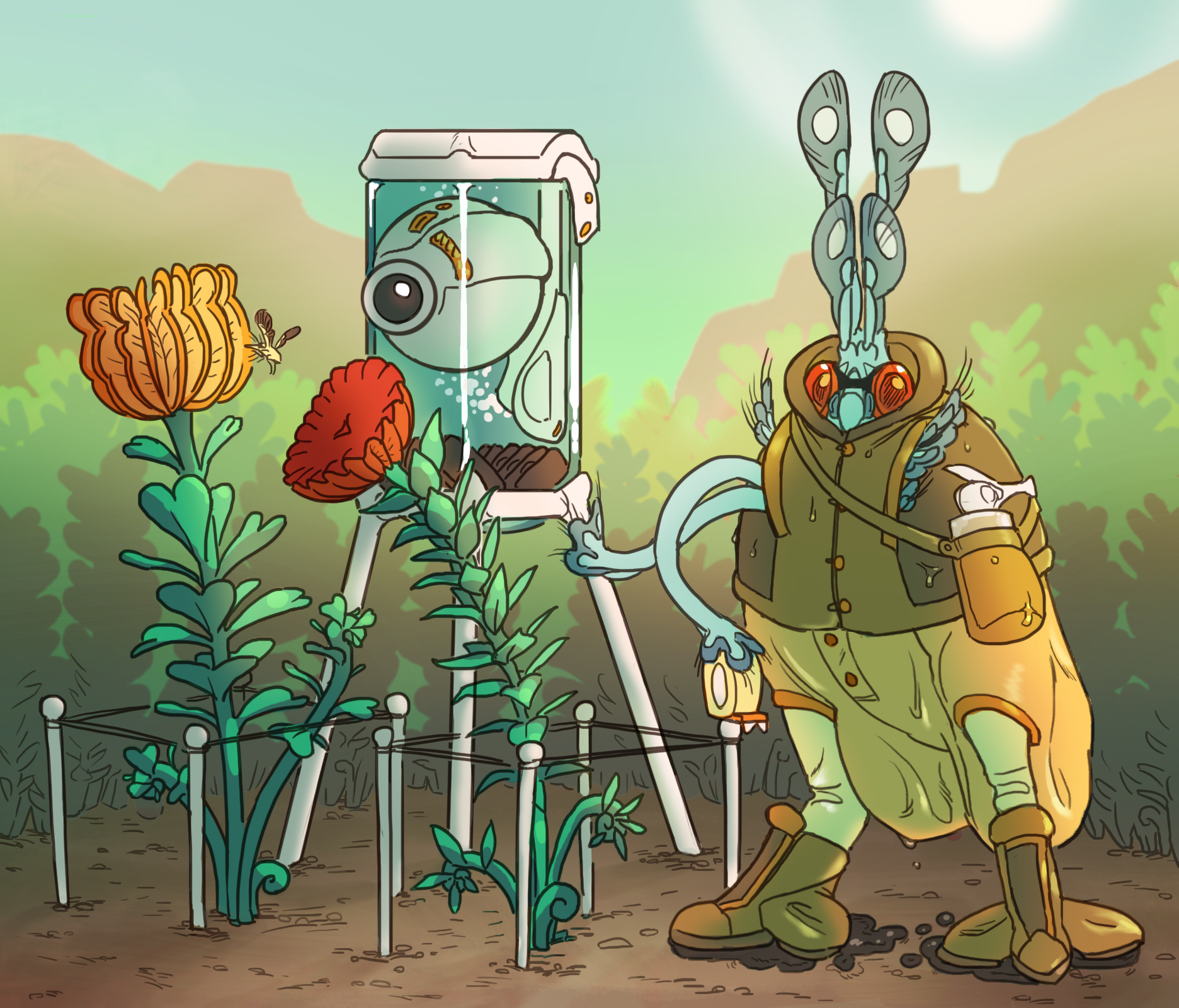
A scud terranaut working on a research site for terrestrial “plants” and their pollinators. Deep inland studies pose unique difficulties for researchers– although they’re fine on brief seashore jaunts, long periods on land can be uncomfortably dry and hard on the gills. Terranauts don thick absorbent clothes before leaving the habitank to stay damp longer, and bring a spray bottle of saltwater to periodically freshen up their gills.
Setting up the remote camera posed some unique difficulties, since the biotech innards have a high risk of desiccation and temperature shock on land. The tank’s bubbler/temp regulator was specially grown for this research mission (though the nitrogenous waste neutralizers at the bottom were just bought at the convenience store).
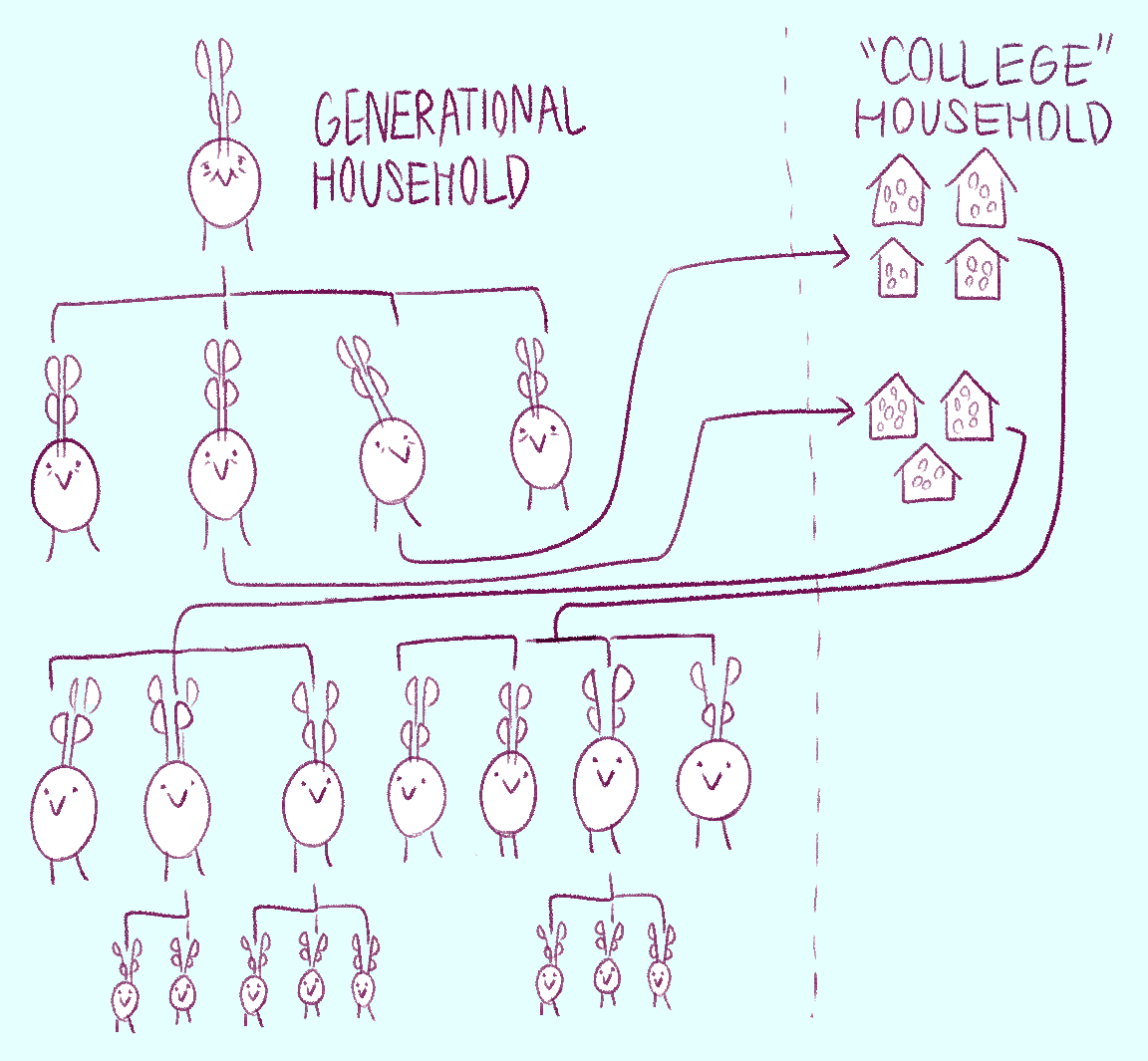
Due to the wind-pollination style reproductive setup kin, friendships, and career are the three biggest factors in determining who to live with, since little can be done to control “mate” selection.
The average scud household is either multi-generational with great grandparents, grandparents, parents, children, etc; or it’s a collection of young adult roommates who travel or study together. After puberty in a scud’s life they get a restless urge to explore and meet new people, which is the best thing their body can do to prevent inbreeding… for most teenage scuds, this involves being sent off to boarding schools and colleges to meet peers and let the restless feeling wear off. In areas where access to boarding education is price or class-locked, local scuds families go back to an older model and let teens go live in local public housing or form loose traveling bands. Child-minded young scuds in either situation usually smash any eggs they lay (or use a reproductive suppressant) and wait for the last clutch before they leave their peers and go back to their multi-generational household to raise kids with family assistance.
Now, this is the ultra traditional family setup– white picket fence not included– and it can get messed up in plenty of fun ways. The most common is when the multi-gen household fragments. If every scud hatched has more kids, the household can grow exponentially and when things get too crowded the closest members may leave and form “sibling houses,” which despite the name often include a few older members.
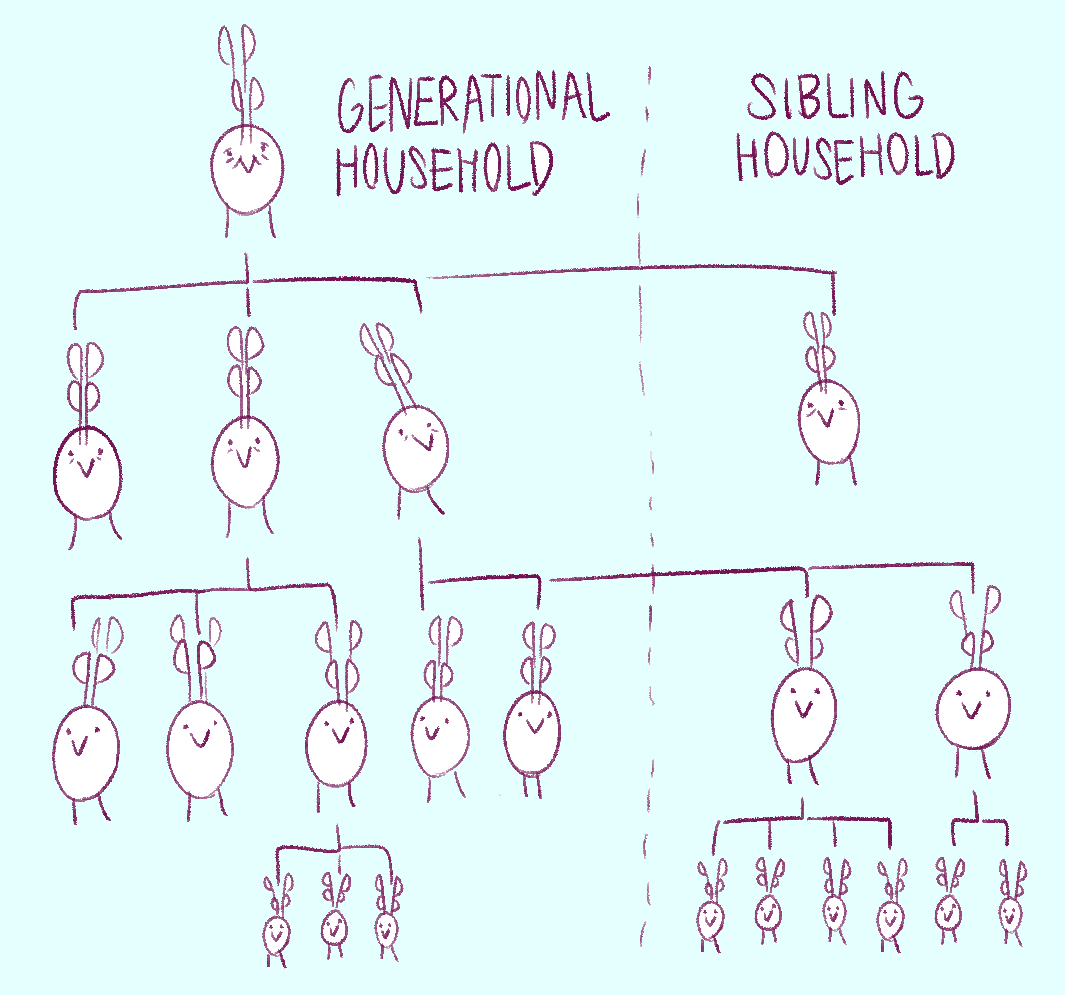
The other common thing is scuds moving out of the family, either for work, higher education, social issues, and etc. Often this involves creating a “college house” or “career house” where they live and raise kids with one or more unrelated scuds. These housing situations are notorious for either working very well or being plagued with drama and falling apart. To be a little clinical, multi-gen households have more motivation to stick with each other because they all share at least some genetics– to help kin is to help perpetuate your own genes. Career households are the next best thing for scuds with abusive multi-gen homes, but just like choosing romantic partners it can be a fraught experience trying to find a good fit.
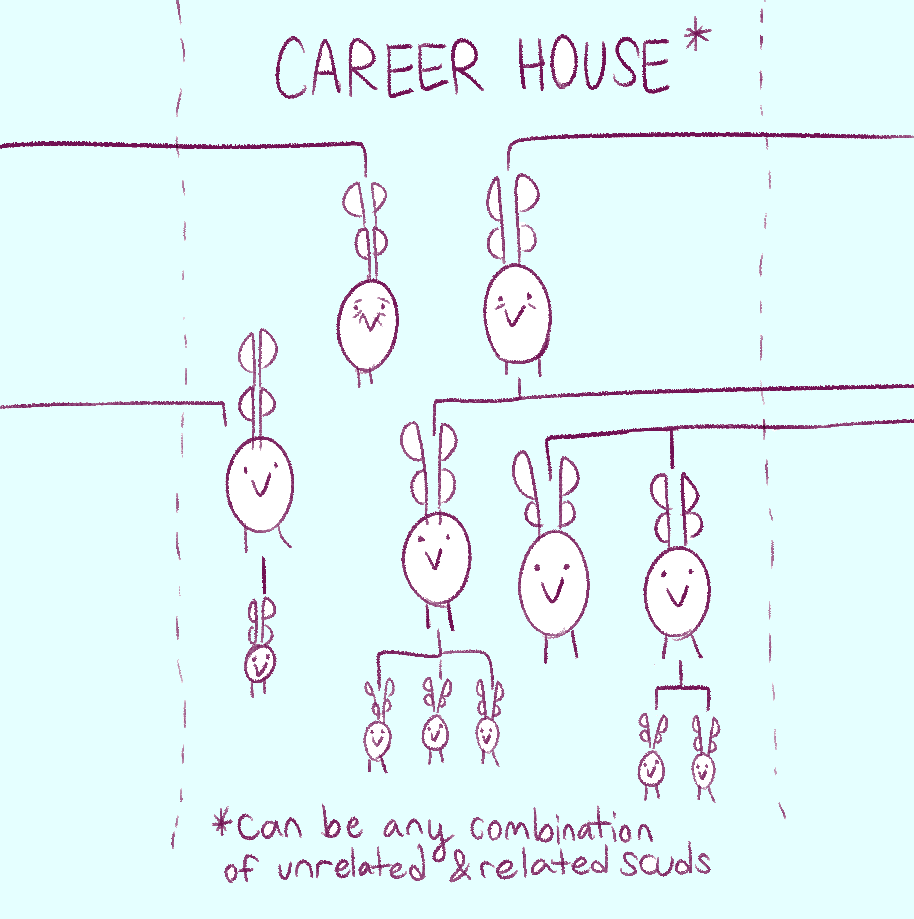
For an odd variation, Chkbrr and Rzzt-tt (the siblings from my comic I’m working on for Patreon, wink) live together apart from their multi-gen house for work/university and neither plan on having kids. Technically they are both a sibling and career household, but having only two scuds and no kids is definitely not the norm for either of those labels.
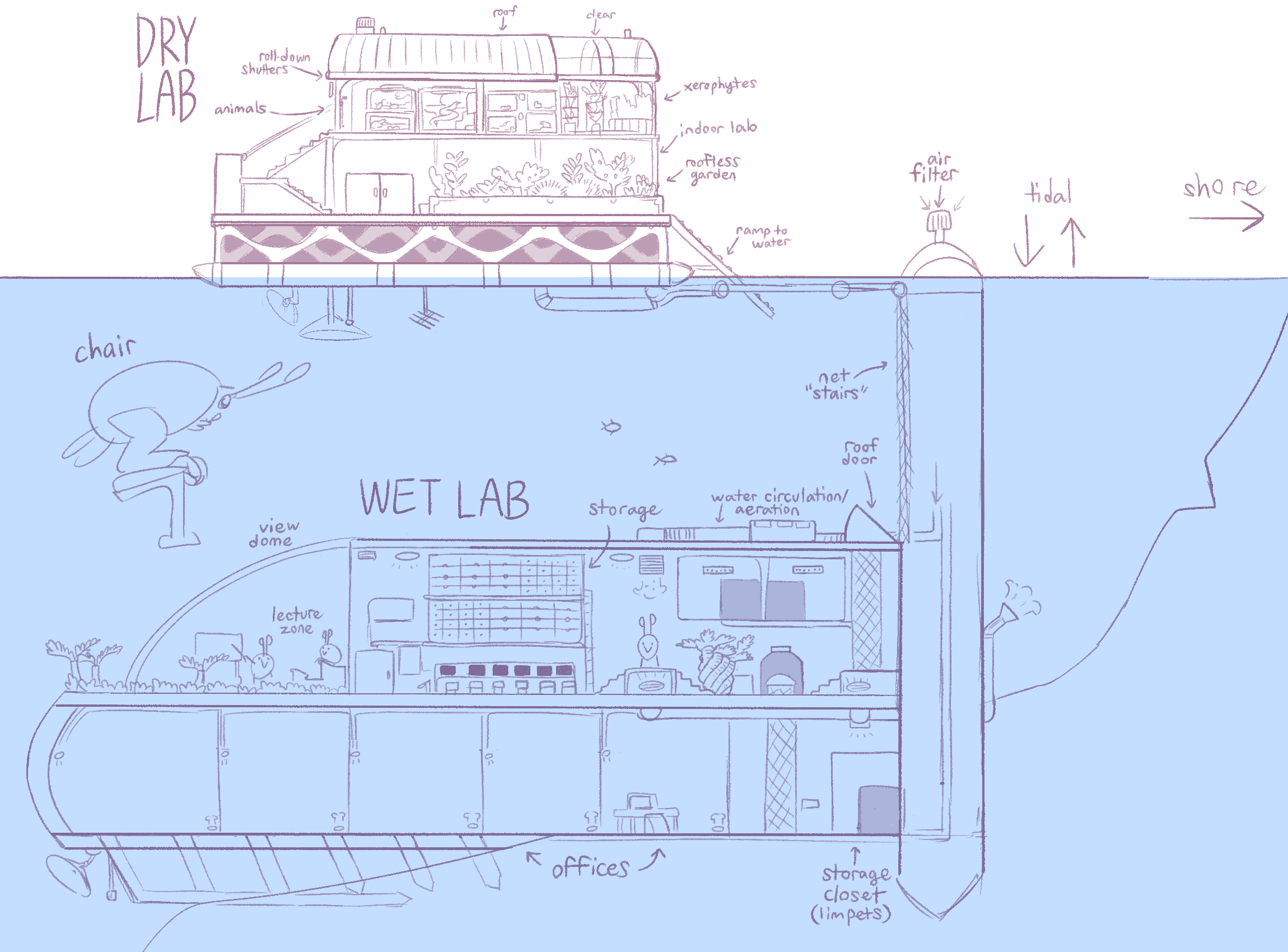
Scuds use a variety of calcium carbonate shell materials to build housing. Crushed shell cements utilize small shelled animals, while enormous shelled “clams“ and “barnacles“ are cultivated for meat and “lumber,” made by strategically cracking the shell into geometric pieces. This lumber is usually held together by resin and dowels, as the shell is too brittle to be nailed together like wood. A more recent building technique uses bioengineered coral to coat scaffolding arranged in the desired shape.
Building structures underwater, especially along the coast where scuds like to live, means waging a constant war against every algae and sessile animal in the ocean trying to colonize your granite countertops. Combined with their rather cavalier attitude towards littering, scud dwellings need to employ a variety of domestic organisms to help clean. Apart from invisible defense like antibiotic mix-ins and engineered anti-colonizer bacterial films, snoombas and cleaner roaches are popular sanitation measures.
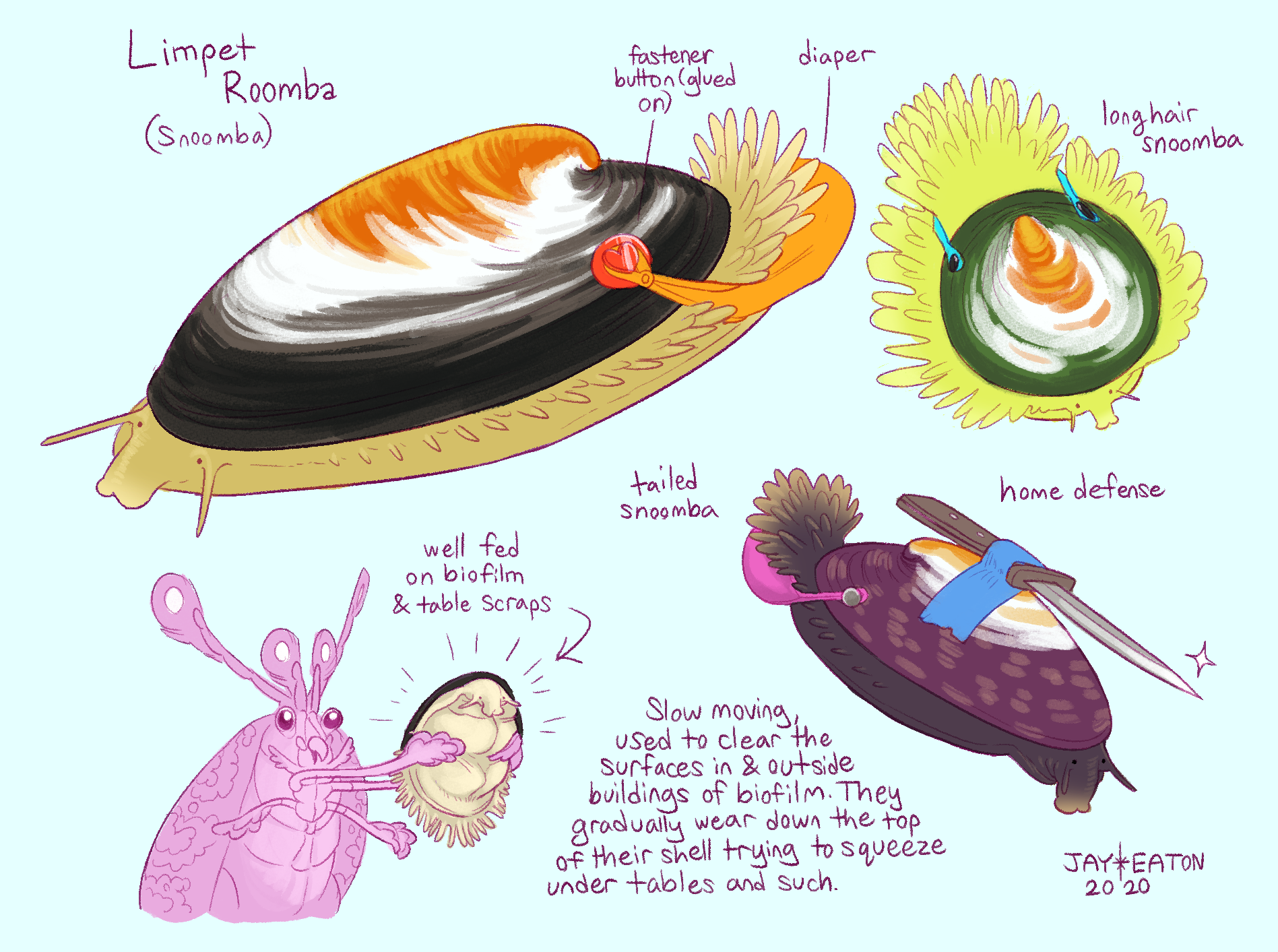
The snoomba continuously patrols the walls, floors, and ceilings of buildings; eating anything it finds. On the outside of structures, they will be quite territorial and will fight other snoombas and slow moving grazers for their prime patch. They are a common sight inside homes, offices, and public buildings as well; though they have to wear a little diaper indoors so that they don’t leave behind the same amount of mess that they consume.
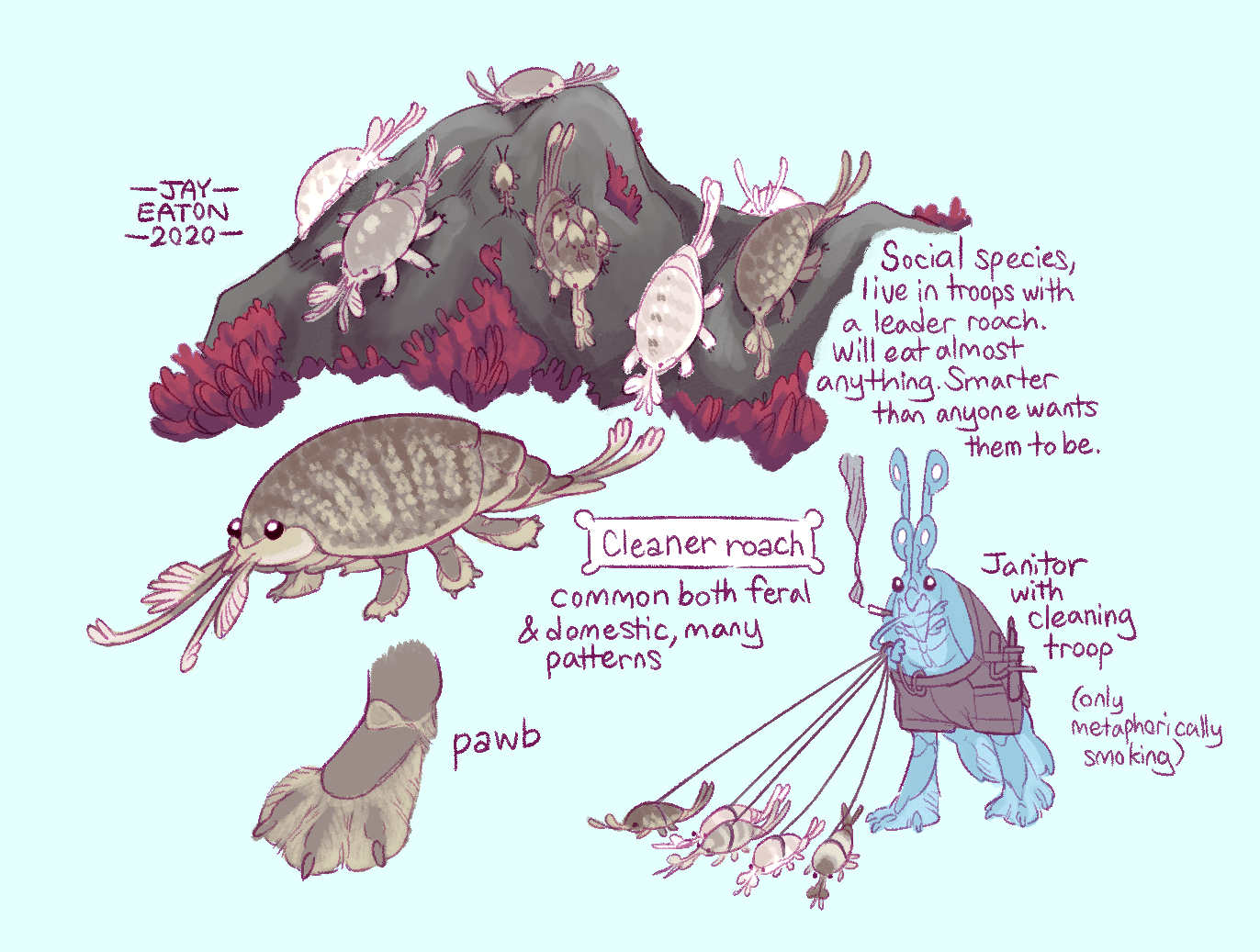
Cleaner roaches are a very social and intelligent little critter from a sister clade of scuds, and are commonly used to clean large buildings and outdoor spaces during the evening. They are nocturnal, usually kept in a little hutch in a janitor closet during the day and brought out by the janitor after hours to make the rounds. Unlike snoombas, cleaner roaches rarely need diapers because they can be trained to use a “litter box” in their hutch.
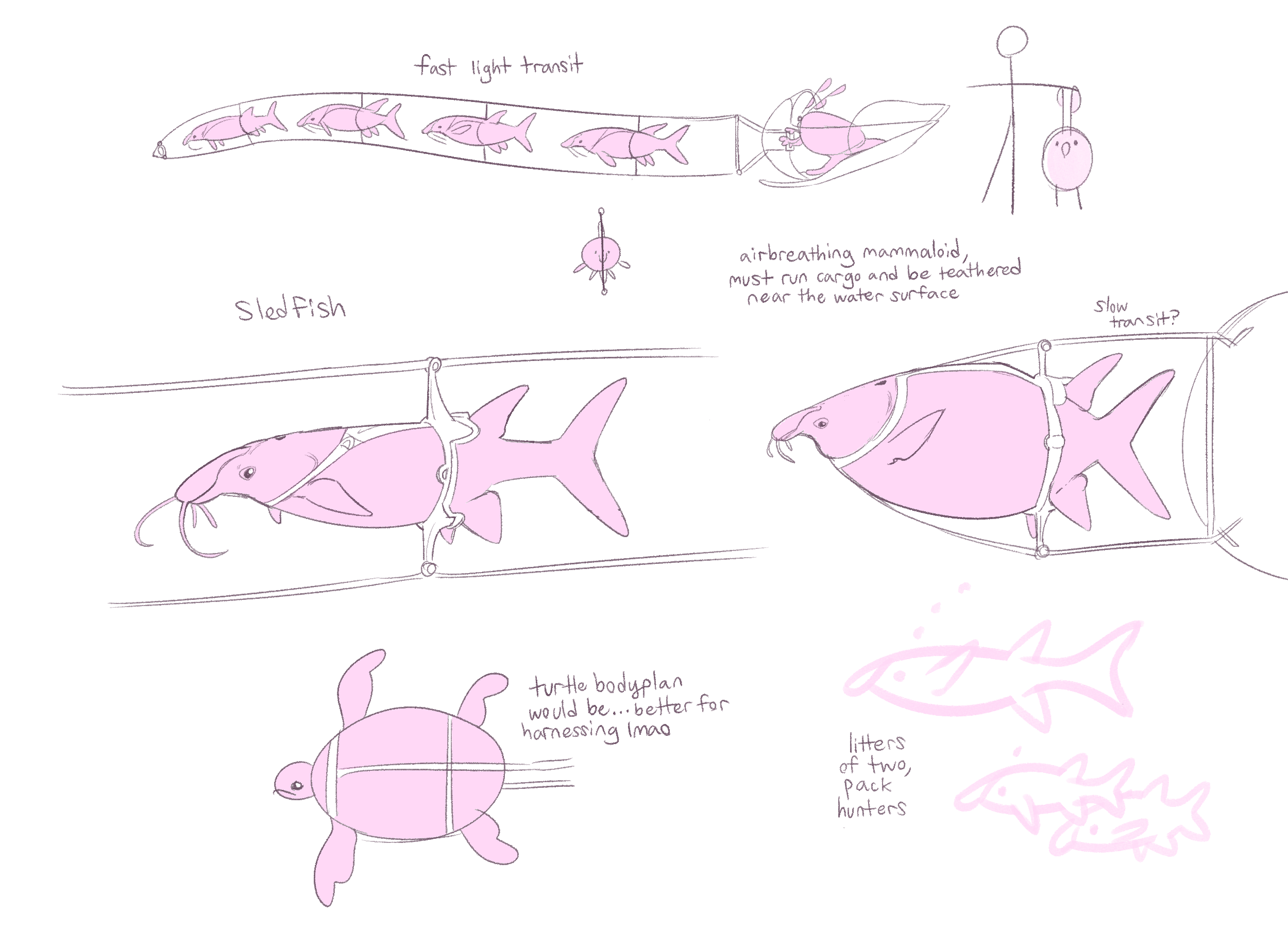

Dry heat is one of many ways to preserve, flavor, and sterilize food! Scuds use heat cooking very little, but I have drawn some of their other methods before. Here’s another old Patreon sketch, colorized for your viewing pleasure.
Scuds most often process their food through curing, dehydrating, pickling, fermenting, and chemical treatment (usually adding strong acids or bases to change the food structure and microbe communities in the container). Shown here is the typical modern pickling setup and basic “cooking” equipment. These tools are of course also used to make intoxicating alcohols, carbonated food, and carbonated beverages. Biotechnologists that they are, there are many modern microbe cultures than can be used to transform food in all sorts of weird ways, like increasing sugar and fat content, removing salt, or dissolving fibers.
For curing it’s often a mixture of salt and dehydration, with the food left out above the tide-line, and doused with new sea water and spices every time the last dose evaporates. Dehydrated food is sometimes vacuum packed for crispness till the moment it’s opened (above or below water, or sometimes packed with a little water so the salt becomes a heady brine.
As for heat cooking, the most common form of it commercially sold is solar cooked food. It’s usually to steam items as well, not really caramelize them. Fire cooking is a thing, as in roasting food with a literal campfire, but it’s very much a special occasion beach party food. The concept of hot caramelized food to a scud is like ice cream to us, it’s a novelty item requiring a special tool and location to make it a weird temperature. Scuds don’t often care about their food getting soggy and cold, for them it’s the natural state of all items. Fire is also a lot more nasty to wrangle for scuds than it is to us, because their gills and tentacle arms are sensitive to desiccation, smoke, and heat damage… hence it being for special occasions, where one might rent a beach-side grill and a grillcook.
Pickling is acid cooking aint it? I mentioned that in the post.
Though that makes me think, a fun way to heat-cook things underwater would be using thermophilic organisms (like the microbes that heat up compost piles) to bring the temperature up inside a ‘wet oven.’ Probably qualifies as a specific kind of fermentation cooking.
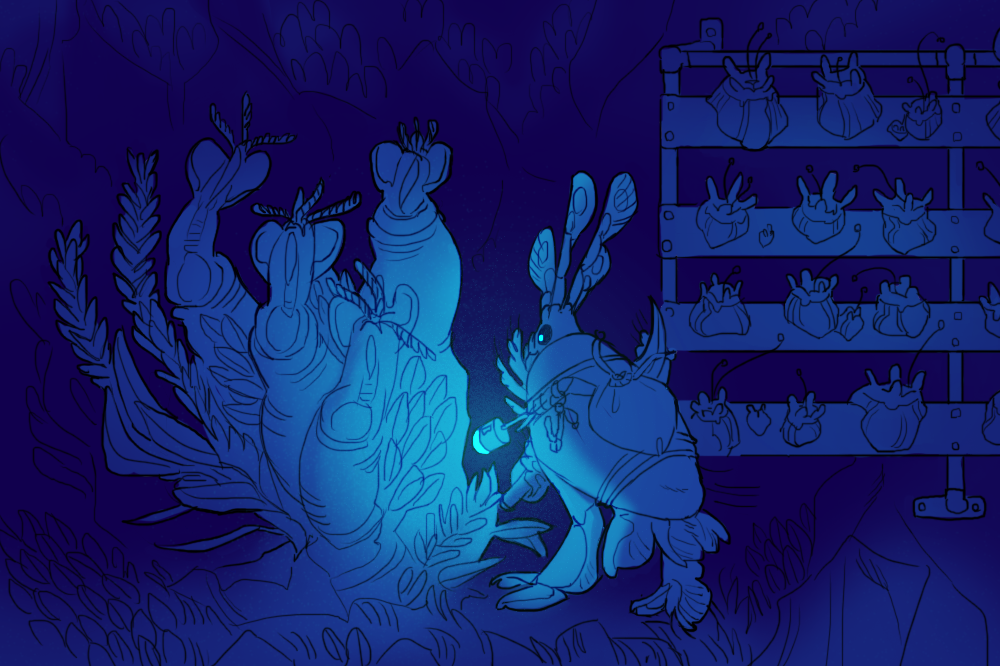
The cool part about gardening underwater is that you can plant animals too! On the left is an aesthetic arrangement of big “tubeworms,” “seaweed,” and hard-shelled filter-feeders. On the right is a food crop of anemone-like animals being grown on scaffolding.
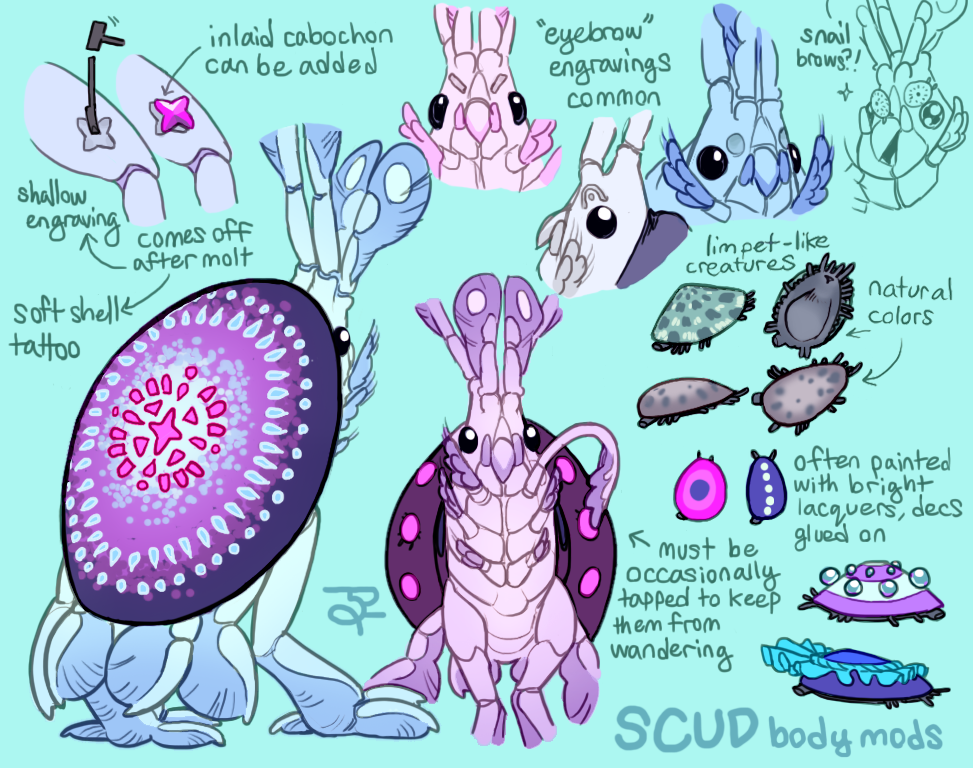
Anything scuds decorate themselves with is either removable, or it just comes off when they molt out of their current carapace. Adults only molt every 2-3 earth years, so tattoos and engravings stick around pretty long but not forever. The “limpets” I drew here are one of many intertidal critters scuds will put on themselves as decoration, but are by far the easiest to care for. Off-duty “limpets” are kept in a small terrarium and fed table scraps. Scuds can rent them from living decoration shops instead, if they don’t want to care for their own dec-snails. Adult scuds also have some issues with unwanted decoration, ie, small marine “invertebrates” and “plants” rooting on their body in between molts. Scraping off sessile hitchhikers is an important part of scud hygiene.
When it comes to clothing for modesty's sake, it's more of an optional thing (depending on the local culture). The most common reasons to wear clothing is for decoration, insulation, or so you can carry more things than your tentacles can hold. Sex appeal is not a factor for sophont scuds, because they don't have sex, their plankton life stage does.
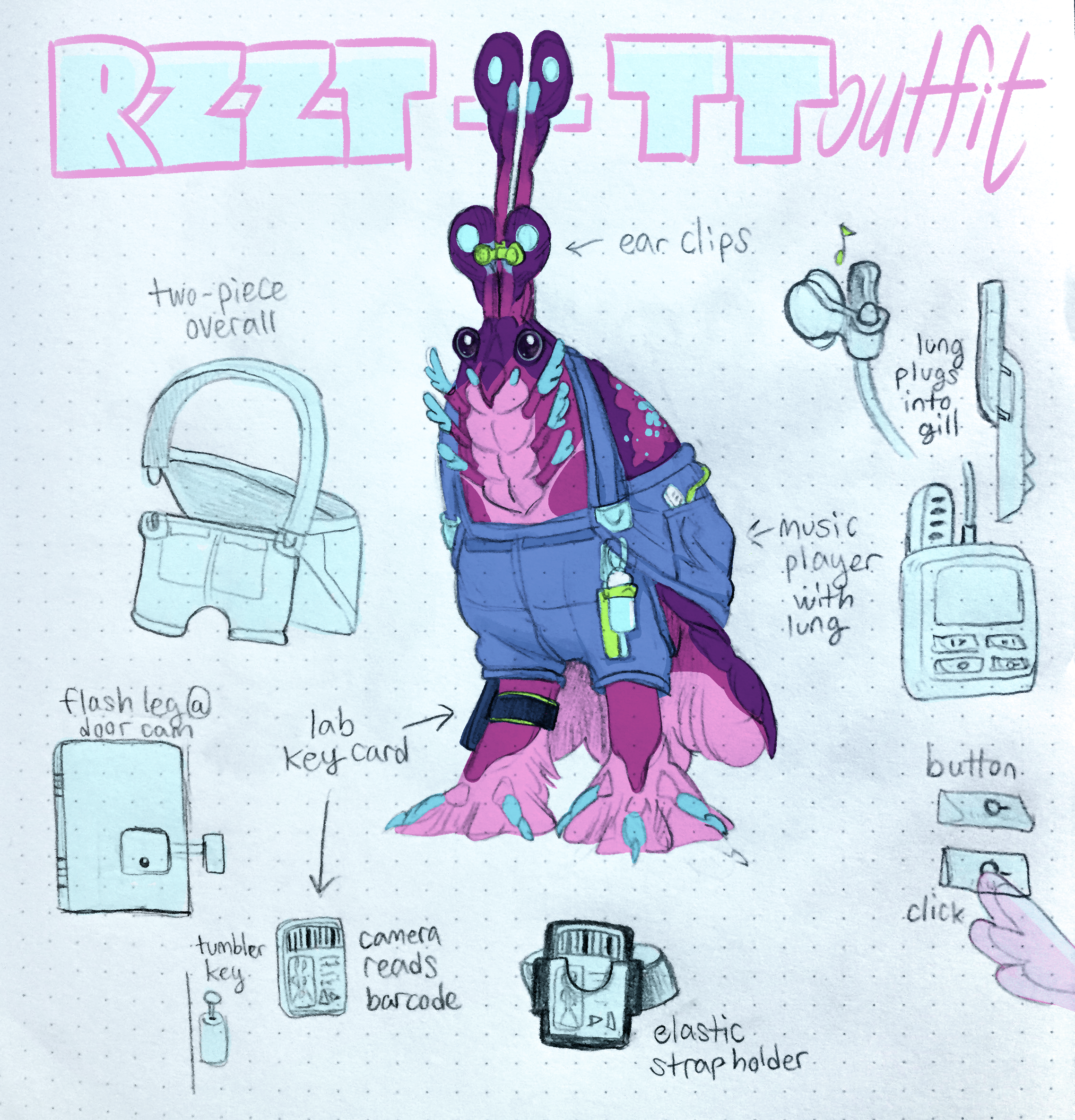
Work in progress.